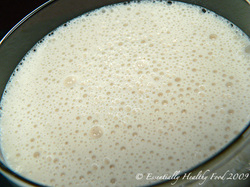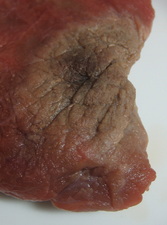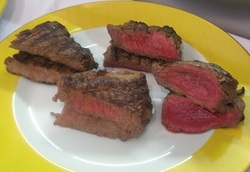Protein
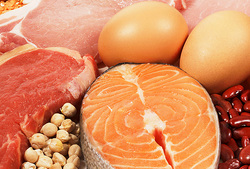
Definition: One of the main nutrients needed by the body to repair and build cells, produce enzymes and hormones, and which can be used as a source of energy
What is a protein?
Proteins are made up of building blocks called amino acids. There are 22 amino acids (8 essential, 14 non-essential) which can be combined in many ways to produce thousands of different proteins
Fill out this Overview Sheet on Proteins, Carbohydrates and Fats
What is a protein?
Proteins are made up of building blocks called amino acids. There are 22 amino acids (8 essential, 14 non-essential) which can be combined in many ways to produce thousands of different proteins
Fill out this Overview Sheet on Proteins, Carbohydrates and Fats
Shape of Protein
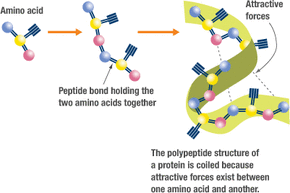
Here is an illustration of the shape of a protein chain
Amino acids are joined together by peptide bonds which form polypeptide chains
The shape formed by this process determines the characteristics of the food in which it is found
Notice the attractive forces forming the coiled shape of the chain
Amino acids are joined together by peptide bonds which form polypeptide chains
The shape formed by this process determines the characteristics of the food in which it is found
Notice the attractive forces forming the coiled shape of the chain
Structure of Proteins
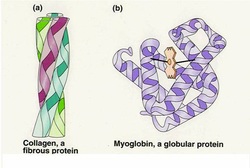
The structure of a protein affects both the qualities of the food and how the food reacts during preparation
This image shows the 2 structures of proteins:
a) Fibrous - Meat, chicken, fish, wheat and baked products
b) Globular - Eggs, milk, yoghurt, cheese, cream
In fibrous structures the coiled helix structure is elongated to form a strand, these strands can be seen when cutting into a piece of meat
In globular structures the protein strands twist into a rounded, compact shape
This image shows the 2 structures of proteins:
a) Fibrous - Meat, chicken, fish, wheat and baked products
b) Globular - Eggs, milk, yoghurt, cheese, cream
In fibrous structures the coiled helix structure is elongated to form a strand, these strands can be seen when cutting into a piece of meat
In globular structures the protein strands twist into a rounded, compact shape
Functional Properties of Proteins
Every protein is different, functioning and reacting in different ways. The two reactions common to all proteins are denaturation and coagulation.
Specific proteins have the ability to denature, coagulate, gel, foam and brown
First we'll talk about denaturation....
Specific proteins have the ability to denature, coagulate, gel, foam and brown
First we'll talk about denaturation....
Denaturation
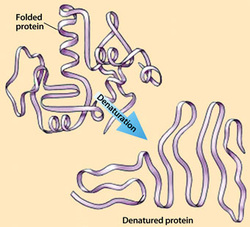
Definition: Protein denaturation is when the helix structure of the protein breaks apart. The bonds are broken causing the strands to separate and unravel.
This separation is caused by 5 factors:
Temperature - Cooking a steak
Agitation - Whisking egg whites
Acidity - Making sour cream and yoghurt
Enzymes - Marinading meats
Salt - Cooking eggs with salted water
Watch this Protein Denaturation Video
Denaturation can be seen in action depending on the type of protein. The denaturation of globular proteins is easy to see.
Remember the jar of milk and lemon juice? That was a denatured globular protein.
Remember the eggwhite foaming experiment? That was another example of a denatured globular protein, the eggwhites started out translucent and as they denatured turned white
The denaturation of fibrous proteins is not as easy to see because the structure is stronger and not as easily affected by the factors that denature globular proteins. Denaturation is eventually visible, think of a marinaded piece of meat, the acid used softens the meat making it more tender to eat
This separation is caused by 5 factors:
Temperature - Cooking a steak
Agitation - Whisking egg whites
Acidity - Making sour cream and yoghurt
Enzymes - Marinading meats
Salt - Cooking eggs with salted water
Watch this Protein Denaturation Video
Denaturation can be seen in action depending on the type of protein. The denaturation of globular proteins is easy to see.
Remember the jar of milk and lemon juice? That was a denatured globular protein.
Remember the eggwhite foaming experiment? That was another example of a denatured globular protein, the eggwhites started out translucent and as they denatured turned white
The denaturation of fibrous proteins is not as easy to see because the structure is stronger and not as easily affected by the factors that denature globular proteins. Denaturation is eventually visible, think of a marinaded piece of meat, the acid used softens the meat making it more tender to eat
Coagulation
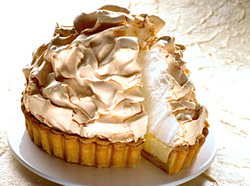
Definition: When a protein separates from other nutrients and turns from a liquid to a solid
Coagulation occurs after denaturation. After the bonds holding the helix shape break apart and the denaturation process continues the next step is coagulation. The denatured proteins start to rejoin, forming a different structure and a solid mass
If coagulation continues for too long overcoagulation will occur where the proteins shrink and toughen forcing liquid out from inside the proteins
Coagulation occurs after denaturation. After the bonds holding the helix shape break apart and the denaturation process continues the next step is coagulation. The denatured proteins start to rejoin, forming a different structure and a solid mass
If coagulation continues for too long overcoagulation will occur where the proteins shrink and toughen forcing liquid out from inside the proteins
Gelation
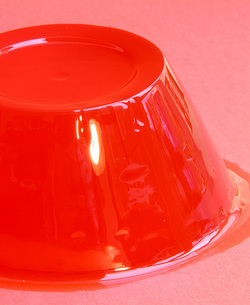
Definition: Gelation is the process of gel formation
Gelation occurs after coagulation
Gels can be described as elastic solids
Gelation can occur in both proteins and carbohydrates however the gelation of proteins occurs when tiny droplets of liquids become trapped within coagulated proteins, this forms soft elastic foods such as custard, junket and cheese
For gels to form, heat, acids and enzymes must be present
Complete this worksheet on Gelation and Browning
Gelation occurs after coagulation
Gels can be described as elastic solids
Gelation can occur in both proteins and carbohydrates however the gelation of proteins occurs when tiny droplets of liquids become trapped within coagulated proteins, this forms soft elastic foods such as custard, junket and cheese
For gels to form, heat, acids and enzymes must be present
Complete this worksheet on Gelation and Browning
Foaming
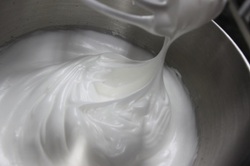
Definition: When air is beaten into a liquid creating a foam
Example: Eggwhites being beaten for meringues, souffles and cakes
The aeration of eggwhites is affected by 4 factors, these are:
Temperature - better results at room temperature
Acids - small amounts i.e. cream of tartar slows the formation of foam but increases its stability
Agitation - Faster beating and finer blades produce greater and finer foam
Addition of other ingredients - Fat (egg yolk) prevents foam forming so keep the bowl and beaters clean.
- Water increases volume but decreases stability
- Sugar if added towards the end makes the foam shinier, finer and more stable
Watch this video on how to beat egg whites, it goes over most of the points above
An example of this process can be seen in the foaming of eggwhites below
Example: Eggwhites being beaten for meringues, souffles and cakes
The aeration of eggwhites is affected by 4 factors, these are:
Temperature - better results at room temperature
Acids - small amounts i.e. cream of tartar slows the formation of foam but increases its stability
Agitation - Faster beating and finer blades produce greater and finer foam
Addition of other ingredients - Fat (egg yolk) prevents foam forming so keep the bowl and beaters clean.
- Water increases volume but decreases stability
- Sugar if added towards the end makes the foam shinier, finer and more stable
Watch this video on how to beat egg whites, it goes over most of the points above
An example of this process can be seen in the foaming of eggwhites below
3
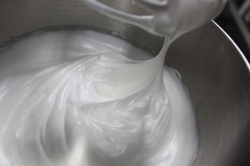
If beating is continued the bubbles become smaller and the foam becomes whiter and finer in texture.
The film of liquid protein around the bubbles becomes thinner and the proteins within the film become more solid
Stiff peaks are soon formed allowing the foam to hold its shape when the beaters are removed, at this stage the proteins are partially coagulated
If beating continues coagulation occurs, this is a visible process in which the surface shrinks and liquid weeps from the clumps of protein
The film of liquid protein around the bubbles becomes thinner and the proteins within the film become more solid
Stiff peaks are soon formed allowing the foam to hold its shape when the beaters are removed, at this stage the proteins are partially coagulated
If beating continues coagulation occurs, this is a visible process in which the surface shrinks and liquid weeps from the clumps of protein
Browning
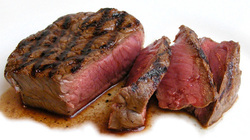
There are three reasons why foods containing protein turn brown. These are:
1. Oxidation
2. Non-enzymic browning
3. Maillard reaction
Oxidation
Definition: Oxidation is the process of red meat turning from bright red to brown due to exposure to the air.
Have you ever noticed red meat on the shelves in grocery stores turning brown on the surface? This is because of oxidation
Think Oxidation = Oxygen
Myoglobin and haemoglobin are the proteins responsible for the bright red colour of meat with myoglobin also causing colour changes
The process of oxidation involves:
1. Myoglobin is exposed to air (leaving meat uncovered)
2. Oxygen changes the iron in myoglobin producing oxymyoglobin
3. Oxymyoglobin turns into metmyoglobin which is brown
So....
Myoglobin > Oxymyoglobin > Metmyoglobin
(bright red) (red) (brown)
The factors which speed up this process are high temperatures, freezing temperatures, ultraviolet light, certain metals and bacteria
How do you reduce oxidative browning? Wrap meat or remove oxygen from the package
Readthis article on the treating of meats to reduce oxidative browning
Non-enzymic browning
Definition: This process involves applying heat to red meat to brown it (cooking), oxygen is not a factor in this process
The protein Myoglobin denatures, turning the meat from pink to brown to grey
This change in colour happens from the outside inwards because the outside gets the heat first
The change is complete when the temperature reaches 82C on the inside and the meat is classed as 'Well done'
Definition: This process involves applying heat to red meat to brown it (cooking), oxygen is not a factor in this process
The protein Myoglobin denatures, turning the meat from pink to brown to grey
This change in colour happens from the outside inwards because the outside gets the heat first
The change is complete when the temperature reaches 82C on the inside and the meat is classed as 'Well done'
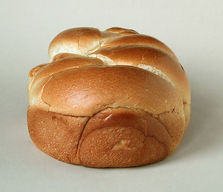
Bread displaying the Maillard reaction
Maillard reaction
Definition: The application of dry heat to a food containing both protein and sugar
This reaction is characterised by a dark yellow to brown crust on cooked food for example roast meat, bread, cake, custard, cereals and fried chips. This reaction contributes to the appeal of these foods, the crunchy outside of fried chips, the crust of a loaf of bread or the crispy outside skin on roast chicken
How do you achieve the Maillard reaction?
Baking, roasting, grilling, barbecuing and frying
What do these cooking methods have in common?
They use dry heat to cook the food as opposed to steaming and boiling which use moist heat and do not produce a crispy crust
Definition: The application of dry heat to a food containing both protein and sugar
This reaction is characterised by a dark yellow to brown crust on cooked food for example roast meat, bread, cake, custard, cereals and fried chips. This reaction contributes to the appeal of these foods, the crunchy outside of fried chips, the crust of a loaf of bread or the crispy outside skin on roast chicken
How do you achieve the Maillard reaction?
Baking, roasting, grilling, barbecuing and frying
What do these cooking methods have in common?
They use dry heat to cook the food as opposed to steaming and boiling which use moist heat and do not produce a crispy crust

